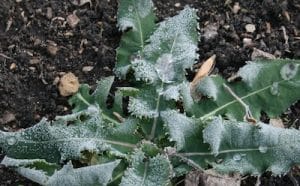When to spray weeds after a frost?
After a light frost, spraying could resume when the following conditions are met:
- A minimum of one night with minimum temperature of 5°C. (Note that this is a general comment, and applies to glyphosate. Tank mix partners may work differently under cool conditions.)
- A minimum of one day of good growing conditions (warm and sunny) have passed.
- Good growing conditions (warm and sunny) are present at the time of spraying.
- You see no evidence of frost damage (blackening and water soaked appearance) on the crop or the weeds. “Crop” is included here because even a herbicide-tolerant canola crop requires that the metabolism of the plant be working at full capacity to enable it to effectively process the herbicide and prevent injury. Here are links for more on spring frost and fall frost and snow scenarios. More on frost at the Canola Encyclopedia.

Tips to spray in the wind
Spraying with wind speeds higher than 15 km/h will increase drift. Here are some tips to reduce the risk in slightly windier conditions (as long as wind is blowing away from higher risk areas, like the neighbour’s yard or recently emerged crops):
- Use low-drift nozzles.
- Increase water volumes to improve coverage with large droplets.
- Find a nozzle that can achieve a coarse spray at a broad range of pressures.
- Aim for 100% overlap nozzle to nozzle to provide equal coverage across the whole boom width.
- Keep the boom low.
- Travel slower to reduce the amount of fine droplets, and make it safer to drive with the boom lower.
See the Canola Encyclopedia for more on reducing drift. One option is to spray at night if the winds are more calm (but not completely calm because inversions can lead to unpredictable drift.)
Tips for spraying in dusty conditions
Dry conditions and wind can cause dust build-up on weed leaves, which may limit herbicide uptake. Most products are not strongly affected by dust, but two important products are very dust-sensitive: glyphosate and diquat (Reglone and others).
Active ingredients in these products are very “charged”, therefore they bind readily and strongly to soil particles, which includes not only dust on plant surfaces, but also suspended soil in spray water. This is the same reason why hard water affects glyphosate. Full article.
Tips for spraying before a rain
Spraying in the rain is not advised. Product washes off before it gets absorbed. However, spraying just before a rain — allowing time to satisfy label requirements for rainfastness — can provide effective control, especially if rains are forecast for a few days and weeds are growing strong.
Rainfastness is different for each herbicide. This article has more details but check the latest product labels for updates.
Efficacy when spraying in cool conditions
Herbicides in general tend to work best in warm sunny conditions when weeds are actively growing and cycling nutrients into their growing points. Performance is on a sliding scale.
- Cloudy days with highs of 10°C after a night near 0°C will tend to result in herbicide performance at the low end.
- Sunny days with highs of 15°C after a night of 3°C will provide improved control.
- Sunny days with highs of 20°C to 25°C after a night of 10°C will provide optimum control. This article has more details.
Efficacy when spraying in hot conditions
- Weeds: Warm, sunny days when weeds are activity growing are generally the best for herbicide activity, but hot weather reduces efficacy, especially if conditions are also dry.
- Flea beetles: Flea beetle activity is lower under extreme hot temperatures and, perhaps more importantly, insecticide performance is lower in hot conditions.
More on hot temperatures and herbicide and insecticide performance.
When to spray post-emergence if you missed pre-seed burnoff?
Seeding and then spraying means that winter annual and perennials will be that much larger, and harder to control, and makes it even more important (if that’s possible) to apply the in-crop application early. Economics of early weed control
Guides to crop protection
With any challenging spray scenario, it can help to check on restrictions and recommendations listed on the label. Here are good places to start:
